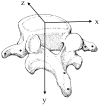Intervertebral mobility in the progressive degenerative process. A radiostereometric analysis
- PMID: 15150701
- PMCID: PMC3476609
- DOI: 10.1007/s00586-004-0713-5
Intervertebral mobility in the progressive degenerative process. A radiostereometric analysis
Abstract
Three separate stages have previously been defined in the progressive degenerative process. The first stage, characterized as temporary dysfunction with early degenerative findings, transforms into a second period of segmental instability evidenced by a resulting deformity. With the deformity the process has reached a late stage of definitive stabilization induced by osteoligamentary repair mechanisms. To test the validity of this three-stage hypothesis, we assessed the intervertebral mobility for the two most-distal lumbar disc levels in 18 adult patients with low back pain, disc degenerative findings and no prior spinal surgery. Each spinal segment was categorized according to grade of disc degeneration: (IA) normal disc height without dehydration; (IB) normal disc height with dehydration; (II) disc height decreased by less than 50%; (III) disc height decreased by at least 50%; and (IV) disc height obliterated. The intervertebral mobility was measured by radiostereometric analysis (RSA) and compared between the categories. With the patient changing position from supine to sitting, the mean vertical translation across the 11 discs categorized as IA was 2.0 mm. A small increase in mean vertical mobility with progressive loss of disc height through the degenerative stages IB (2.2 mm, seven discs) and II (2.6 mm, ten discs) was not significant. Further degeneration to grade III meant a significant mean reduction in vertical mobility to 0.8 mm for the eight discs in that category. No discs were classified as obliterated, category IV. The corresponding values for sagittal translations were 3.0 mm, 3.1 mm, 3.6 mm and 1.7 mm for the four disc categories found. These alterations were not statistically significant. We conclude that intervertebral mobility changes throughout the degenerative process, and a stage of stabilization begins when disc height is reduced by 50%. The segmental mobility status cannot be deduced from the radiographic, degenerative disc stage, since the inter-individual differences in mobility are pronounced for the same disc status. A fully stable situation cannot be taken for granted, even when the disc is reduced by more than 50%, considering the fact that some persisting mobility was seen for most patients in category III. A preceding stage of instability, in the clinical situation proven by a resulting deformity, was not verified in this study.
Figures



References
Publication types
MeSH terms
LinkOut - more resources
Full Text Sources
Medical

